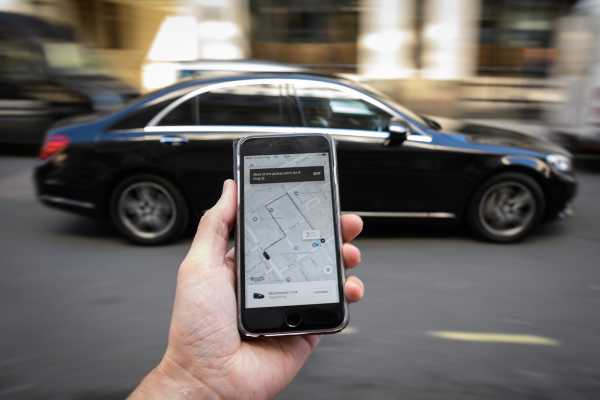 other to go public. Here’s why.” alt=”Uber and Lyft are racing each other to go public. Here’s why.” />
other to go public. Here’s why.” alt=”Uber and Lyft are racing each other to go public. Here’s why.” />
Uber and Lyft are racing each other to go public. Here’s why.
The ride-hailing apps filing for IPO will bring some much-needed transparency to the gig economy.
By
Chavie Lieber@ChavieLieber
Dec 12, 2018, 5:20pm EST
Share
Tweet
Share
Share
Uber and Lyft are racing each other to go public. Here’s why.
tweet
share

The ride-hailing company Lyft announced last Thursday that it had filed confidentially with the Securities and Exchange Commission for an initial public offering. Hours later, sources told the Wall Street Journal that Uber had also filed for IPO with the SEC that same day. Now, the two companies are facing off to become the first to go public sometime during 2019.
Uber and Lyft have been battling each other for dominance in the ride-hailing space for years, and going public, where shares of their company will be openly available to buy and sell on the stock market, will be a major step for both of them. In addition to getting enormous payouts, both companies will enjoy the buzz that comes with an IPO, which Uber needs as it struggles with seemingly nonstop scandals, and which Lyft needs since it perpetually lives in Uber’s shadow.
Uber, which launched in July 2010, is the ride-hailing industry’s king. It says it has 75 million riders and 3 million drivers, and completes 15 million trips a day; studies estimate it controls 60 percent of the market. It’s raised more than $15 billion in funding since 2009 and made $37 billion in revenue last year. Uber also has a $72 billion valuation, which it’s rumored will jump to $120 billion when it does go public.
Lyft is Uber’s main competition, although the playing field isn’t exactly even. Uber is exponentially larger and has international recognition, with a presence in more than 60 countries, while Lyft only operates in the US and Canada. Still, Lyft is reportedly growing nearly three times as fast as Uber. It has a $15 billion valuation and claims to control 35 percent of the ride-hailing space.
By leaving the experimental, erratic startup world and getting listed on the New York Stock Exchange, Uber and Lyft will assume images of being mature, stable, and transparent companies — a reputation neither has necessarily earned just yet. (Both Uber and Lyft declined to comment to Vox for this story.)
Their IPOs could also have major implications, as they will be the first companies in the so-called gig economy to go public; Gallup estimates that 36 percent of the American workforce, or 57 million workers, now work in the gig economy. By sharing their closely held internal information with the public, as companies do in their SEC filings, Uber and Lyft will reveal how much they profit while gig workers fight for rights, which could open the floodgates for change.
Why Uber and Lyft are filing for IPO
Uber and Lyft are credited with completely changing transit by causing car sales to decline, hobbling the yellow cab industry, and acting as replacements for major modes of transportation. (There are several other smaller companies in the car-sharing and ride-hailing space, like Via, Juno, Gett, and Turo, but Uber and Lyft are the most visible and the most valuable.)
In their mission statements, Uber and Lyft say they’re in the business for the good of humanity; Lyft’s mission statement is to “improve people’s lives with world’s best transportation,” while Uber’s is to “ignite opportunity by setting the world in motion.” But the companies are also clearly interested in staking their claims in the huge and lucrative transportation industry, which nets a global $4.2 trillion annually, according to Plunkett Research.
In addition to trying to conquer ride-hailing, Uber acquired the bike-share startup Jump, dove into the electric scooter wars by investing in Lime, and has continued to pour billions into self-driving car research as it spars with Google’s Waymo. Lyft, too, has moved beyond ride-hailing; it acquired the bike-sharing network Motivate (which operates New York’s Citi Bike) and is debuting electric scooters of its own. Lyft also jumped into the self-driving car space by acquiring the augmented reality startup Blue Vision Labs.
While a company like Uber has clearly not had trouble raising money to fund its expansion, it is now filing for IPO because having its stocks sold on a public exchange is a way to obtain cash easily and quickly, as opposed to constantly courting private investors, says Matt Pencek, the director of MorganFranklin, a consulting firm that advises Fortune 500 companies in IPOs.
“The public market provides greater liquidity,” says Pencek. “Stocks can be bought or sold tomorrow, and so money is more readily available, as opposed to waiting on investors. The difference between public and private is like owning a home but being told you have to wait for a buyer to come to you, or that you can only sell your home to a few people every few years.”
“Uber and Lyft might have created an innovative model around ride hailing years ago, but today their marketplace is easy to mimic, and so that’s why they’ve been really focused on growth,” he adds. “They are moving from a business model innovation company to a product innovation one through autonomous vehicles and AI. It’s hard for a company to switch their business model, and so going public will provide liquidity.”
Pencek notes that tech is an industry that’s primed for IPOs (Amazon, eBay, and Apple all filed for IPO only a few years after hitting the market).
“Tech-centric companies want to go public sooner in their life cycle so that they can get capital, pump it back into the business, and scale,” he says. “It’s not like a manufacturing business where $1 spent is a $1.20 return. These companies can easily grow when they’re handed money.”
By jumping into the public market, Uber and Lyft will have access to capital to fuel their ambitious growth plans — and so if you’re sick of hearing about self-driving cars or a future built on electric scooters, get ready. Filing for IPO means Uber and Lyft are only just getting started.
It’s not just about money: Uber needs a facelift, and Lyft needs to bolster its identity
As Recode reporter Theodore Schleifer wrote earlier this week, Lyft beat Uber to file with the SEC — and the rush was strategic.
Lyft plans to go public as early as the first quarter of 2019, while Uber likely won’t hit the stock exchange until late 2019. Lyft has always operated in Uber’s giant shadow and doesn’t have name recognition internationally, as Recode notes. But filing for IPO comes with buzz. Going public can make a company sound sexy, between the headlines, financial analysis, and rush to buy stock, and so it was important for Lyft to be first.
“If you’re an institutional investor who is eager — after years of watching two meteoric privately held startups amass value — to get exposure to U.S. ride-hailing, there will be a few months during which you will have one option and one option only: Lyft,” Schleifer writes. “[It] is defining its own category on the stock market rather than ceding that turf to Uber.”
Uber’s jump into becoming a public company is just as much a marketing move; if there’s any company that needs the PR help, it’s Uber. The company is constantly dealing with scandals, lawsuits, and executive shake-ups. In 2017, founder and former CEO Travis Kalanick was ousted, after reports of Uber’s alleged culture of machismo and a blog post about its purported institutional sexism went viral. Under his leadership, these allegations went, Uber was riddled with inappropriate workplace conduct and discrimination — incidents that are currently part of a federal investigation over gender discrimination.
Uber has also been accused of illegally spying on competitors, stealing trade secrets, and using a secret software program called “Greyball” to hide its cars from regulators in cities where it wasn’t legally allowed to operate. And in March 2018, one of Uber’s self-driving cars killed a pedestrian in Arizona.
Dara Khosrowshahi, who replaced Kalanick as CEO, has vowed to reform Uber. Part of this change is taking the company public. It will signal that Uber is ready to be taken seriously and operate with more stability — both internally and externally.

“People tend to look at public companies as mature,” says Pencek. “It provides a sense of accountability because public companies have to report on a quarterly basis and are subject to the regulatory process. It opens you up to an entire set of investors who drive transparency, and so filing for IPO could show you are ready for that.”
Going public isn’t a guaranteed win. Shareholders expect profits, and they can be demanding. (Nordstrom, for example, has even tried to take its business private so that it can pivot within the struggling department store space accordingly, without having to air its strategy to the public every four months.) But it also gives a company an air of prestige and a sense of order — something Uber could use.
“When you’re public, you run by a consistent rhythm of controls and process, because otherwise, it erodes confidence in the company,” Pencek says. “It shows that they have their act together.”
What will these IPOs mean for the gig economy?
Uber and Lyft’s imminent arrival on the stock market will be a telling moment for the gig economy, according to Robbie Kellman Baxter, the author of The Membership Economy, who also runs the consulting firm Peninsula Strategies.
With these huge companies exposing their inner structures, workers will finally get a glimpse of how much they actually cost to operate — and how much these companies are making off their backs. While gig economy workers say they appreciate the flexibility, they’ve also been fighting for years for rights like health insurance and workers’ comp. Baxter believes workers will want to unionize — and probably should, as going public will force Uber and Lyft to face the ugly accusations of worker mistreatment within the gig economy. And considering they will be trading next to giant corporate entities that offer competitive benefits and perks, Uber and Lyft might want to start treating their workforce like employees.
“When Uber started, they were hiring drivers who saw the job as a hobby or side gig, but there are tons of drivers who say it’s an important part of their livelihood, and that makes Uber an important employer, whether or not they like to admit it,” she says. “Once they become public, there are certain norms of companies that they’ll have to follow. They’ll have to normalize as a business.”
Uber could certainly continue to designate its workers as “contractors” and thereby deny them certain protections or benefits. (Amazon, for instance, recently raised wages to $15 an hour for all its employees but chose not to apply these changes to its contract workers, who operate as part of its gig-economy-esque arm, Amazon Flex.) But Baxter believes a public move like filing for IPO will leave room for gig economy workers seeking fair rights to speak up. With the world watching these two giant startups’ moves over the coming months, the workers might finally have a shot at getting heard.
Sourse: vox.com






